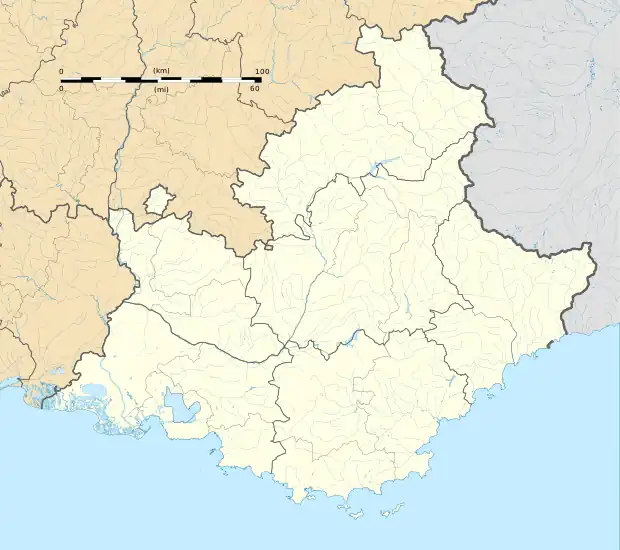Roure | |
|---|---|
 The church of Saint-Laurent and the town hall, in Roure | |
_%252B_Devise.png.webp) Coat of arms | |
Location of Roure | |
 Roure  Roure | |
| Coordinates: 44°05′28″N 7°05′20″E / 44.0911°N 7.0889°E | |
| Country | France |
| Region | Provence-Alpes-Côte d'Azur |
| Department | Alpes-Maritimes |
| Arrondissement | Nice |
| Canton | Tourrette-Levens |
| Intercommunality | Métropole Nice Côte d'Azur |
| Government | |
| • Mayor (2023–2026) | Yanne Souchet[1] |
| Area 1 | 40.3 km2 (15.6 sq mi) |
| Population | 113 |
| • Density | 2.8/km2 (7.3/sq mi) |
| Time zone | UTC+01:00 (CET) |
| • Summer (DST) | UTC+02:00 (CEST) |
| INSEE/Postal code | 06111 /06420 |
| Elevation | 500–2,339 m (1,640–7,674 ft) (avg. 1,132 m or 3,714 ft) |
| 1 French Land Register data, which excludes lakes, ponds, glaciers > 1 km2 (0.386 sq mi or 247 acres) and river estuaries. | |
Roure (French pronunciation: [ʁuʁ]; Occitan: Rore; Italian: Rora) is a commune located in the department of Alpes-Maritimes department in southeastern France in the Provence-Alpes-Côte d'Azur. Its inhabitants are called Rourois. It is a medieval village with agro-pastoral architecture.
Geography
The village is situated at the entrance of the Tinée Valley, at the edge of the Mercantour National Park, at an elevation of 1100 m. The village is accessible by road from Nice through the RN 202, towards Digne then 2205 RD, the RD 30 and RD 130. Also by path through the GR 5. The village contains five little villages: Rougios, lost in the mountains, Tiecs, la Cerise, Puch and Valabres where there was a priest and a school until 1904.
Toponymy
The first indication of the village dates from 1067 under the name "Rora", derived from the Latin word "robur" which means "oak". Villagers raised and tended cows and goat herds on behalf of their owners and concluded business under a large oak tree. Hence, the origin of the village's name.
Main sights
See also
- Communes of the Alpes-Maritimes department
- Communes of the region Provence-Alpes-Côte d'Azur. Traditionally named Provence.
References
- ↑ "Répertoire national des élus: les maires" (in French). 28 June 2023.
- ↑ "Populations légales 2021". The National Institute of Statistics and Economic Studies. 28 December 2023.